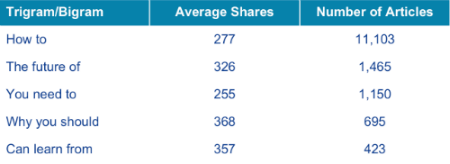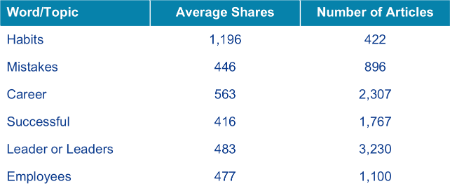
by Fronetics | Jan 3, 2017 | Blog, Content Marketing, Marketing, Social Media
The most popular content from LinkedIn in 2016 offers some headline inspiration for businesses hoping to improve reach and impact in 2017.
Buzzsumo’s Steve Rayson wrote an article the other day that really struck a chord with what we do here at Fronetics: He used data to analyze patterns in successful content. More specifically, Rayson examined the most popular content posted on LinkedIn in 2016 and identified headlines and topics that were most successful last year.
The results are really interesting and say a lot about what content resonates with the general LinkedIn community. I’ve summarized his findings below.
Most popular headline phrases
Rayson examined the 10,000 most-shared posts on LinkedIn in 2016 and identified the most common two- and three-word phrases from their headlines. Some of the most frequent included:
- How to
- You need to
- Why you should
- Can learn from
- The future of
Rayson then pulled all the headlines from 300,000 posts using these phrases. He found that not only did more headlines include these phrases, but also that posts with headlines using these phrases received more shares than average.
For context, the average number of shares for all LinkedIn posts in November 2016 was 230. Here are Rayon’s findings.

Most impactful headline words and topics
Rayson conducted the same exercise for single words or topics in headlines. His table below shows some of the best-performing words and their social reach.

How can I write better headlines?
Rayson concludes from his analysis that LinkedIn’s top-performing content — in terms of shares — usually involves instruction on how to be successful in one way or another. This is probably no surprise, given the network’s career-oriented nature. But it can be useful to marketers who are looking to create and distribute content through this platform in the coming year.
Rayson’s takeaways offer some useful suggestions for framing LinkedIn content to improve reach and impact.
- Write about success: We all aspire to do better as professionals. LinkedIn is a place we come to find advice. The core topics that do well are personal success (tips, career advice, personal skills, leadership) and business success (team management, sales, including staying ahead on top of industry trends and case studies).
- Share advice and make it personal: Does your content provide practical advice to someone personally? It can range from boosting sales to managing a difficult employee or boss. Can you appeal to users on a very personal basis, e.g. you need to or you should.
- Focus on work: Will your insights make someone more successful at work? Can you distil this down into habits or tips or mistakes to avoid.
- Talk trends and the future: Can you provide insights into industry trends and help people gain a better perspective on the future?
- Stick with what works: If you find a format that works, do not be afraid to reuse it.
Related posts:


by Fronetics | Jan 2, 2017 | Blog, Content Marketing, Logistics, Marketing, Social Media, Supply Chain
It’s time to cast your vote for the top blog in the supply chain and logistics industries!
Fronetics is conducting its 3rd annual survey to uncover the top industry blog of 2017. Help us by voting for your favorite blog. Responses will be collected through January 25, 2017. Vote now so your voice will be heard!

All responses are confidential and will be reported in aggregate. No identifiable information (individual or company) will be attached or included. Please contact [email protected] with any questions.
Interested in who won in 2015 and 2016?

by Fronetics | Dec 22, 2016 | Blog, Content Marketing, Marketing
At Fronetics, we work with companies in the logistics and supply chain industries to create and execute digital and content marketing strategies. Understanding the sales processes of our clients, working closely with sales, and developing effective lead generation strategies is at the heart of what we do.
Here are our 5 most read sales and lead generation posts of 2016.
Sarah Collins, an intern Fronetics and a student at James Madison University, College of Business studying Marketing, writes how aligning sales and marketing helps companies achieve 20% higher annual growth rates and improves deal closings by 67%. Read more.
Leads are only valuable if they convert into customers. So, generating quality leads is only half the battle. You need a sales team that knows how to resuscitate a lead, nurture it, and, ultimately, turn it into a customer. Read more.
B2B sales must recognize and accommodate buyers at various levels of self-sufficiency in the purchasing process. Read more.
The most efficient lead-generation strategy includes a way to capture potential customers’ information. Read more.
If you feel your marketing campaign falls short in generating quality leads, you are not alone. Typically, one in 10 marketing professionals questions the effectiveness of their lead generation methods. While you may have some of the components of a strong campaign in place, it is possible that you are leaving out a very important ingredient for success: a call to action (CTA). Read more.


by Fronetics | Dec 21, 2016 | Blog, Diversity, Leadership, Logistics, Manufacturing & Distribution, Strategy, Supply Chain, Talent
Women hold just 15% of all executive officer positions within Fortune 500 companies, yet research consistently shows that when women are in positions of leadership, companies perform better. In the supply chain industry, just 5% of top-level supply chain positions within Fortune 500 companies are held by women.
As a woman working within the supply chain industry, I believe that it is important to discuss the lack of gender diversity and point to research highlighting why the industry needs to increase the number of women in all positions, including the C-suite. It is just as important to highlight the incredible women who already are working within the industry.
In 2015 I interviewed Cathy Morris, senior vice president and chief strategy officer at Arrow Electronics, and Mickey North Rizza, vice president of strategic services at BravoSolution. Morris was twice named one of the “Top 50 Most Powerful Women in Technology,” and North Rizza was named a “Top Female Supply Chain Executive.” Both Morris and North Rizza shared how they got started in the industry, and the steps they have taken to get to where they are today.
In 2016 I interviewed Kendrea Durr-Smith, director of global trade compliance at Arrow Electronics, Kelli Saunders, President of Morai Logistics, Hailey McKeefry, editor and chief at EBN, and Barbara Jorgensen, co-founder and managing editor, EPS News. I also invited Tania Seary, founder of Procurious, to share what is happening at her company, and Jennifer Cortez, director of marketing and communications at Transplace, to discuss the role of quality content within the industry.
Here are the most-read women in the supply chain posts of 2016.
It was a “fluke” that Kelli Saunders found the supply chain industry. More than 30 years later, Saunders is president of Morai Logistics Inc., an Authorized Agent of Mode Transportation. Read more.
When Arrow Electronics came across Kendrea Durr-Smith, senior leader of export control audits, training, and communications at Honeywell Aerospace, on LinkedIn, the company was impressed with what she had accomplished in her nine years there. Now Arrow’s Director of Global Trade Compliance for the last four years, Durr-Smith has led a group that is both unique and diverse, and has helped to shepherd in significant changes. Read more.
Data shows that gender equality has improved in recent decades, such as the 15% increase of women working full time in the workforce since 1979. But there is still much progress to be made. As a recent UN Working Group mission to the US to explore discrimination against women found: “In the US, women fall behind international standards as regards [to] their public and political representation, their economic and social rights, and their health and safety protections.” Read more.
Women within the supply chain industry are doing incredible things. Here are some of their stories. Read more.
While there remains a gender gap in the supply chain industry, progress has been made. McKeefry is a clear example of progress. Her internship at EBN in 1990 was a “minority internship,” and today, 26 years later, she holds a leadership position within the company. Read more.
Barbara Jorgensen has more than 20 years’ experience as a journalist, working for leading electronics industry publications such as Electronic Business, Electronic Buyers’ News, and EDN. She is the co-founder and managing editor of EPS News. Read more.
This is a guest post written by Tania Seary, founder of Procurious, the world’s first online social network for supply chain and procurement professionals. Seary shares how she has built Procurious. Read more.
This is a guest post by Jennifer Cortez, Director, Marketing Communications, Transplace. Cortez discusses how Transplace, a North American non-asset-based provider offering manufacturers, retailers, chemical and consumer packaged goods companies the optimal blend of logistics technology and transportation management services, has used content marketing and she offers up 3 tips for creating valuable and compelling content. Read more.


by Fronetics | Dec 20, 2016 | Blog, Leadership, Strategy, Supply Chain, Talent
The 10 most popular talent posts of 2016.
The start of a new year generally brings with it a host of resolutions. For individuals finding and landing a new job, or advancing in their current job are common resolutions. For companies, identifying talent, hiring, and retaining great talent are typical goals for the new year.
We’ve assembled our top 10 talent posts of 2016. We hope these posts help you and/or your company overcome challenges, and your achieve goals.
A veteran recruiter explains where the supply chain talent shortage is headed and how companies can overcome the challenges. Read more.
This guest post by Argentus Supply Chain Recruiting, a boutique recruitment firm specializing in Supply Chain Management and Procurement, asks the question: If there is a Supply Chain talent deficit, why are so many people in the field having trouble finding work? Read more.
The global supply chain is continuously evolving, offering new opportunities as demands shift and new technologies are born. But how do you evolve with it? We offer 5 things you can do to advance your logistics or supply chain career. Read more.
LinkedIn offers immeasurable opportunity for recruiting premium talent. But how do you begin weeding through the network’s more-than-433-million candidates? Here are some techniques — both free and fee-based — on using LinkedIn to find professionals who match your company’s open positions. Read more.
Networking can do more than help you find your next job opportunity; it can make you smarter, happier, and more financially stable. Read more.
Building a stronger relationship between academia and the supply chain industry is one way to solve the growing talent gap. If your company is looking to hire, consider strengthening your rapport with schools that offer supply chain programs or specialties. Read more.
If your job has left you to feeling stuck in a rut, try these steps to improve your professional life. Read more.
Your business is growing, and it is time to hire. That means facing the challenge and overcoming the fact that there is a dearth of supply chain talent. Growth is very common right now, as job titles evolve and shift due to the rapid changes in supply chain management and new technological requirements. So more talent is in demand as many businesses try to remain competitive. Seek out candidates with these skills and experiences when hiring new supply chain talent. Read more.
This guest post by SCM Talent Group, a national supply chain recruiting and executive search firm, discusses a new webinar series centered around the talent aspects of the supply chain discipline. The purpose of this series is to provide low-cost, high-impact solutions and advice that employers, hiring managers, and HR partners can implement in efforts to improve their abilities in attracting, hiring, and retaining top supply chain talent. Read more.
Family businesses can be a source of pride and fulfillment. But, often, they are rife with unprecedented turmoil. Working for a family business presents unique challenges that require special tactics to keep things professional (and to keep the peace). Read more.













